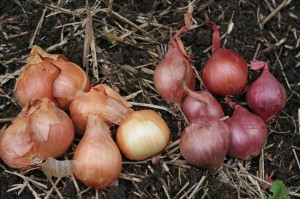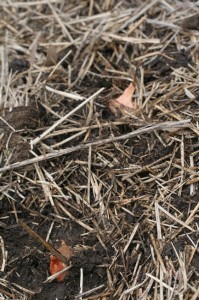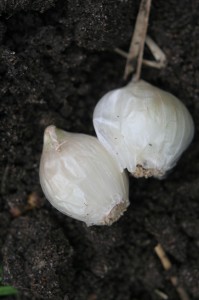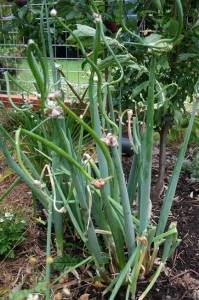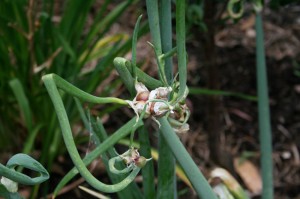
Tree onions produce bulbils instead of flowers. The bulbils sprout so that the plant looks like a small tree.
In the early 1900′s the American writer O. Henry wrote that “A stew without onion is worse’n a matinée without candy” and I’m sure that chefs all over the world would agree with him. Cooks and gardeners are familiar with the common bulb onion (Allium cepa), different cultivars of which provide a range of oniony flavours but what about the other onions: shallots and the ever-ready, potato and tree onions? When Jonathan Swift wrote in 1700
“But lest your kissing should be spoil’d,
Your onions must be thorough boil’d”
he was probably talking about these alternate onions which have been grown and valued by gardeners for centuries. They are usually propagated from bulbs which multiply to form more bulbs, rather than by planting seed. They are also disease and pest resistant making these onions much easier to grow than common bulb onions.
Shallots, A. cepa (Aggregatum group), are similar to potato onions but their bulbs are generally longer than they are wide. Most can be grown by planting individual bulbs. Each bulb then produces from 2 to 20 new bulbs (usually about 10) during the growing season. Some shallot cultivars can be grown from seed with each seed producing only one bulb, however if these bulbs are replanted they will usually produce a clump of bulbs the following year. In France there are more than 100 named cultivars of shallots available, while in Australia there are only a handful. But many shallots were brought into Australia by immigrant families and have been passed down through the generations so if your ask at your local gardening group you may be able to locate one of the older or more unusual cultivars.
The shallot cultivars most commonly available through seed suppliers are the ‘Golden’ and ‘Red’ types. Shallots can also be grown from bulbs purchased in green grocers and supermarkets but these have often been treated with sprout inhibitors so that they sprout much later than normal and so don’t produce proper bulbs the first year.If they are left in the ground they will reshoot and grow properly in the second year. These bulbs can be planted from late autumn to spring, with the tops of the bulbs just showing above the soil, for harvest in summer. Shallots are valued by chefs because of their mild, sweet and subtle flavour and the fact that they soften more readily making them particularly useful for sauces.
Potato onions, A. cepa (Aggregatum Group) are perennial onions that were listed in Australian catalogues in the early 1800′s under a variety of names including hill, mother, multiplier, pregnant and underground onion. They were once grown commercially but modern farming methods needing onions that can be machine planted and harvested meant that potato onions fell out of favour. Generally they are classified according to skin colour, so that red, brown and white forms can be found. Potato onion bulbs are usually broader than they are tall and one bulb will produce up to 15 more each year. Save about one sixth of the bulbs each year for replanting. Place the bulbs just below the surface of the soil anytime from mid-autumn to early spring. Harvest potato onions about 6 months after planting. Their strong and pungent flavour makes them ideal for winter soups and stews, as well as stir fries and sauces.
Ever-ready onions, A. cepa (Aggregatum Group), are also known as ever-lasting onions and were described by the English plant breeder and grower Clarence Elliot as the “most valuable, the most easily grown and the most prolific onion in existence”. The clump in my garden provides onion greens and small brown skinned white bulbs all year apart from a few weeks in mid-summer. Like all onions they need a well-drained soil, plenty of sunlight and occasional additions of blood and bone in spring, but can otherwise be ignored. They are propagated by dividing clumps and replanting bulbs at any time of the year and will do particularly well in pots as long as they are repotted every couple of years.
The last and my favourite of these unusual alliums is the tree onion, A. cepa (Proliferum Group), also known as the Egyptian, top or walking onion. Instead of flowers, tree onions grow bulbils in their flower heads. These sprout green shoots so that the whole plant resembles a small tree. After a while the weight of the flower head causes the stem to bend, the bulbils touch the ground and grow roots thus producing a whole new plant. Over time the plants ‘walk’ across the garden. Tree onions also increase by growing new bulbs at the base, one bulb will produce between six and ten new bulbs. New plants can be propagated by replanting these bulbs or the bulbils.
They are very tough plants, surviving droughts and downpours, and this combined with their oddity make them excellent for a child’s garden. They provide onion bulbs and greens all year round and need only good drainage, plenty of sunlight and to be dug and replanted every few years.
Sydney Smith, the eminent preacher, writer and lecturer of the early 19th century was renowned for his wit and commonsense. In his Recipe for a Salad, he said “Let onion atoms lurk within the bowl and scarce suspected animate the whole”. Whether you use onions in this or some other way you could not be said to truly “know your onions” unless you are familiar with these ‘other’ onions. — PW
More information about all these onions and other alliums can be found in my book Garlic and friends

